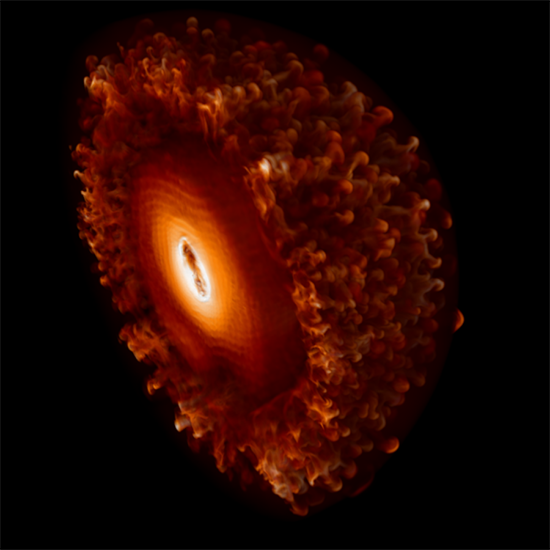研究成果藝廊 > 理論天文物理理論天文物理
(Theory)
研究成果藝廊
理論天文物理理論天文物理 (Theory)
| World’s First 3D Simulations Reveal the Physics of Superluminous Supernovae |
|
圖片來源: Ken Chen et al.

The nebula phase of the magnetar-powered super-luminous supernova from our 3D simulation. At the moment, the supernova ejecta has expanded to a size similar to the solar system. Large scale mixing appears at the outer and inner region of ejecta. The resulting light curves and spectra are sensitive to the mixing that depends on stellar structure and the physical properties of magnetar.
|
| Supernovae are the grandest explosions of the universe and a frontier topic in modern astrophysics with immense scientific richness for theoretical and observational explorations. New supernova searches are revealing new astrophysical explosions in unprecedented numbers, and are revolutionizing our understanding of SNe. Recent discoveries of superluminous supernovae, which are about a hundred times more luminous than typical supernovae, are violently challenging our knowledge of their progenitors, explosion mechanisms, and ambient environments.
We present the first three-dimensional hydrodynamical simulations ever performed of a magnetar-powered supernova with the most powerful supercomputers in the world. This work simulates the supernovae remnant of size ~ 100 AU. However, the size of the neutron star is just 10 km. It requires an extreme resolution to model this system, which proposes a grand technical challenge for astrophysicists. We found that hydrodynamical instabilities form on two scales in the ejecta, not just one as in ordinary core-collapse supernovae: in the hot bubble energized by the magnetar and in the forward shock of the supernovae as it plows up ambient gas. Both fluid instabilities cause more mixing in the explosion than in normal supernovae, with significant consequences for the light curves and spectra of the event that cannot be captured by previous one-dimensional models. This result was recently published in ApJ. |
